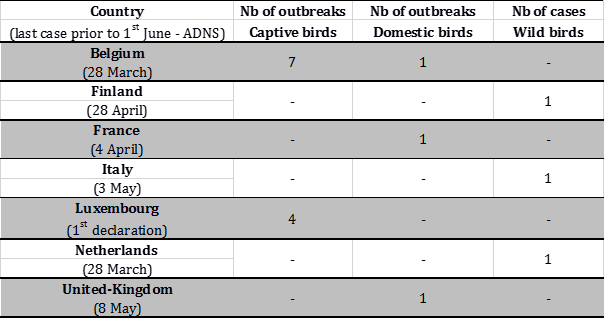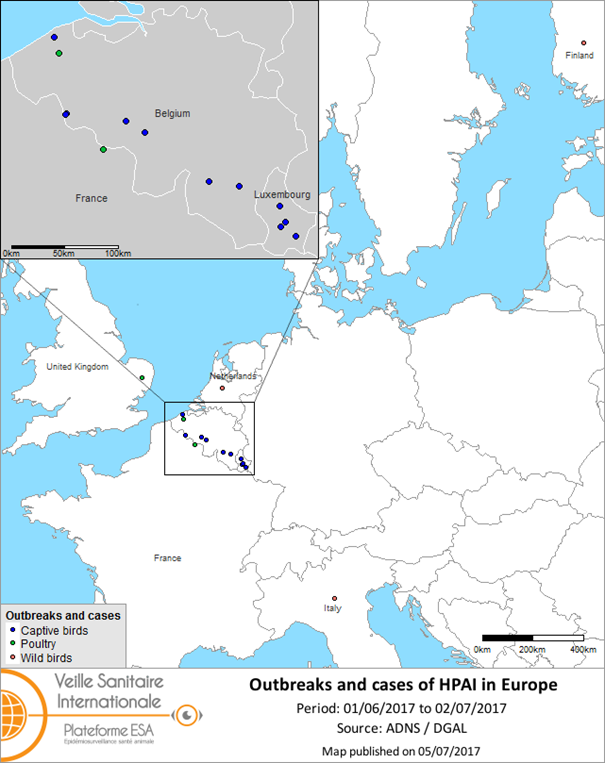Epidemiological situation of HPAI viruses from clade 2.3.4.4 in Europe: situation as of 3rd July 2017
International Animal Health Epidemic Intelligence (VSI) team – ESA Platform – France
Sources: Data updated on 2nd July 2017 (included) ADNS/FAO/OIE, DGAL (General Directorate of Food – French Ministry of Agriculture), ProMED, MAF (French Ministry of Agriculture and Food) press release from 30th June 2017
This is a translation of a published report. The French version of this report is available here.
From 1st June 2017 to 2nd July 2017 (included), 17 cases and outbreaks of H5 subtype highly pathogenic avian influenza (HPAI) were notified in seven European countries : Luxembourg, the United-Kingdom, Italy, Finland, France, Belgium and the Netherlands (Table 1, Figure 1). H5N8 and H5N5 viruses have been identified.
Table 1: Number of HPAI cases and outbreaks notified in Europe from 1st June to 2nd July 2017 in domestic, captive or wild birds (sources : OIE/ADNS/DGAL)
In addition to these 17 outbreaks, three HPAI outbreaks were reported on 21st June in Belgium in a poultry farm and in captive birds, without further information regarding the subtype (H5 or other). Due to lack of information, these outbreaks will not be considered in this report.
The epidemiological situation of HPAI viruses from clade 2.3.4.4 in Europe from October 2016 to May 2017 is detailed in the last situation report published on the ESA Platform website on 31st May (link).
LIKELY EPIDEMIOLOGICAL LINKS BETWEEN OUTBREAKS IN BELGIUM, LUXEMBOURG AND FRANCE
The HP H5 virus was identified in Belgium near the Luxembourg border on 1stJune 2017, then seven other cases and outbreaks were notified from 14th to 27th June, mainly in amateur breeders of ornamental birds (source: MAF).
The virus was then identified in Luxembourg for the first time, with four cases in captive birds confirmed on 2nd and 3rd June 2017 (with no further information regarding subtype).
France confirmed the presence of the H5N8 virus on 30th June in a poultry farm located in Brillon, in the North of the country. This outbreak is likely linked to chicks and pigeons bought on a market in Tournay, Belgium. The poultry farm is located 15km from an outbreak notified on 23rd June in a commercial poultry farm in Tournai, Belgium (source: MAF). Control measures were implemented to avoid further spread of the virus, and a temporary control zone which spans over 3km around the suspected farm was set up on 27th June.
THE H5N5 VIRUS FROM CLADE 2.3.4.4 STILL PRESENT
The HP H5N5 virus is still circulating in Europe. On 1st June, the Netherlands declared a case of HPAI H5N5 in two wild geese (Anser anser domesticus).
THE H5N8 VIRUS FROM CLADE 2.3.4.4 IN ASIA AND AFRICA
The HP H5N8 virus is also circulating outside of Europe. In Asia, health authorities in South Korea have temporarily banned the transport of poultry across the country on 7th June in an effort to contain the new H5N8 epizooty. In Africa, the virus has recently been notified for the first time in South Africa, Zimbabwe (which confirmed its first outbreak in a poultry farm on 17th May), and the Democratic Republic of Congo (where three outbreaks were notified end of May in the Ituri region bordering Uganda where the H5N8 virus is also circulating) (sources: OIE, FAO, ProMED).
Figure 1. Map of HPAI outbreaks and cases notified in Europe from 1st June 2017 to 2nd July 2017 included (sources : ADNS/DGAL)


